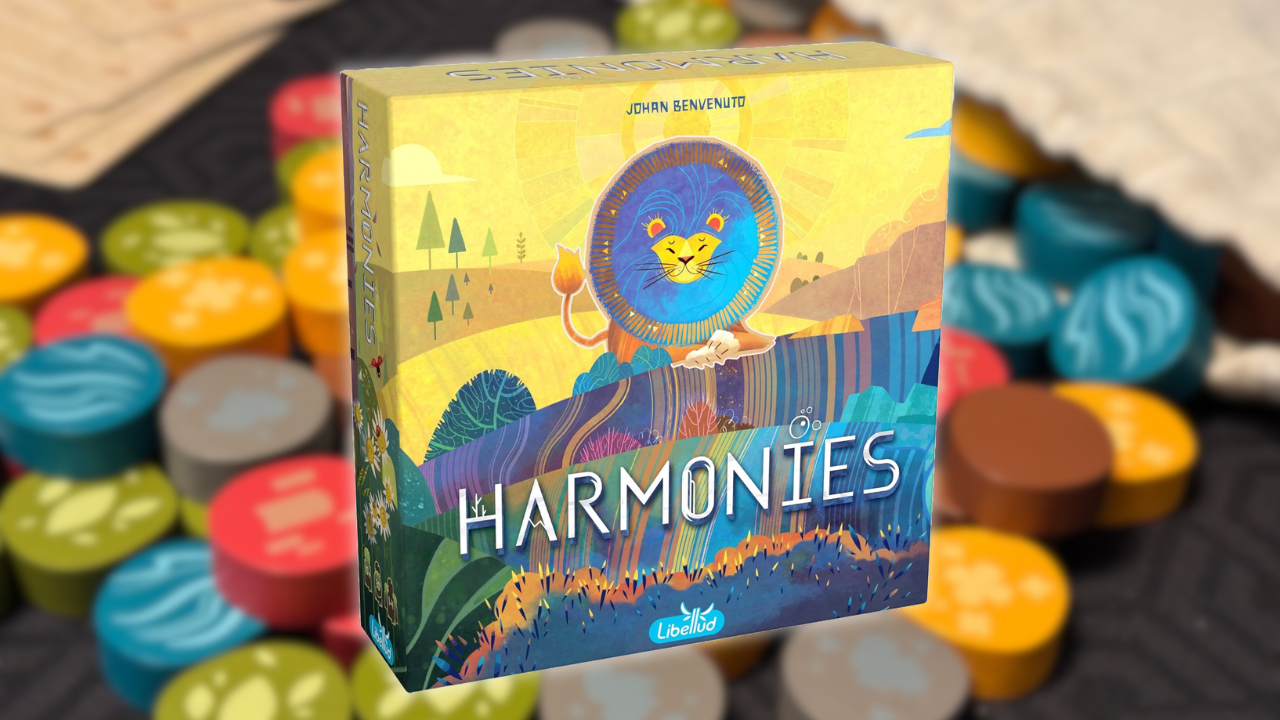
There’s no shortage of great board games these days, especially those centered around animals and nature. Harmonies released into the wild in 2024 and immediately began turning heads with its satisfying gameplay and gorgeous artwork. It feels like the lovechild of Azul and Cascadia, blending Azul’s token drafting with Cascadia’s animal-centric theme and tile-laying mechanics. It fits comfortably in the cozy board game category and makes a great pick for couples and families alike; it’s easy to teach, yet still offers enough strategy and meaningful decision-making to keep more experienced players engaged.
What’s in the Box
Harmonies manages to pack quite a bit into a compact box, as you’ll quickly realize when you lift the lid. Inside, you’ll find three separate rulebooks in English, French, and German, along with QR codes that link to quick video overviews in English, French, German, and Italian.
Beneath the instruction booklets are four sturdy, double-sided player boards and a double-sided central board used for drafting tokens during gameplay. Each set of colorful wooden tokens comes packaged in its own plastic bag for organization during shipping, but you’ll likely find it easier to store them all together in the included linen drawstring pouch. The tokens themselves are high-quality, surprisingly lightweight, and make a satisfyingly tactile sound as they rattle around in the bag.
The box includes a built-in organizer to keep components tidy before and after gameplay. One side of the organizer features a folding cardboard lid that holds a deck of Animal and Nature’s Spirit cards, along with a bag of small plastic orange and clear cubes that represent the animals. Like the box itself, the cards showcase vibrant, stunning artwork of various animals in their natural habitats.
Also included are four double-sided reference cards – one for each player – that summarize how each biome is scored and provide a quick count of how many wooden tokens exist in each color. A small, colorful scoring pad makes it easy to tally up points at the end of the game.
While the built-in organizer is a welcome touch, you’ll need to give the wooden tokens in the linen pouch a quick shake and settle to get everything to fit properly; otherwise, the lid won’t sit flush with the box. That said, setup and teardown are incredibly fast, as there aren’t too many components to manage overall. Once everything’s packed away neatly, the compact box can be stored either horizontally or vertically on a shelf without any worry of components shifting or spilling inside.
Rules and How It Plays
The goal in Harmonies is to create a series of interconnected habitats for your animals by drafting and placing tokens on your player board to earn the highest score. After a quick setup, the first player chooses a set of three randomized tokens from the central board and places all of them on their personal board in any arrangement they like. However, once a token is placed, it can’t be moved for the remainder of the game.
What makes Harmonies stand out is the ability to stack certain tokens, introducing a sense of verticality to the board and offering additional scoring opportunities if specific conditions are met.
For example, brown tokens can serve as the base of a tree, but they don’t score on their own unless a green token is placed on top. Mountains, built using one to three grey tokens, only score if they’re adjacent to at least one other mountain. Fields, represented by yellow tokens, score in pairs of two or more and can’t be stacked, while rivers (blue tokens) score progressively more points the longer you can connect them. Buildings are the most complex to grasp at first; they require a base token – either brown, gray, or red – topped with a red token, and they score a flat number of points if at least three uniquely colored tokens are adjacent.
While this alone would make for an interesting game, the real strategy emerges from drafting Animal cards. Each card features a specific configuration of tokens along the bottom that represents a unique habitat required by that animal. For instance, an alligator might need a swamp made up of a tree and a small river beside it, while meerkats prefer a rocky structure adjacent to a field.
On each player’s turn, they have the option to draft one of the five available Animal cards and add it to their tableau, along with a set number of animal cubes that indicate how many times the depicted habitat must be built. Each time you successfully create the habitat shown on the card, you remove the bottommost animal cube and place it onto your player board, matching the habitat as pictured. As you remove cubes, you’ll earn an increasing number of points.
There’s no penalty for failing to complete an Animal card, but since you’re limited to four cards in your tableau at a time, choosing strategically is important. While it may be tempting to grab a bunch of animal cards early, you may find it difficult to complete the required habitats and miss out on valuable points.
The real strategy in Harmonies lies in optimizing the layout of habitats on your player board – maximizing the number of Animal cards you can complete while also keeping the base scoring of each biome in mind. At its core, Harmonies is an elegant optimization puzzle that presents a fresh challenge each time you play. While each player is primarily focused on their own personal board, there’s still a fair amount of interactivity, as you can block opponents from drafting certain sets of tokens or Animal cards that would perfectly complement their habitats.
At the end of each turn, players replenish the three tokens they took with a random draw from the pouch and reveal a new Animal card if they drafted one. This constant churn forces players to stay flexible – there’s rarely a chance to plan too far ahead, especially in higher player count games where more turns happen between your own. That unpredictability is exactly where Harmonies shines. Each turn carries a subtle urgency: you’re racing to complete as much as you can on your board before the game ends, all while juggling smart decisions and efficient token placement.
In the later rounds, it’s not uncommon to have a well-optimized player board that lets you draft Animal cards and score them immediately, without needing to build additional habitats. It’s a deeply satisfying payoff that rewards careful planning and can earn you some quick points as you push toward the end of the game.
The game ends when the pouch runs out of tokens or when any player has two or fewer unoccupied spaces left on their board, triggering the final round. After that, players tally up their points and declare a winner.
Once you’re comfortable with the base game, there are a few optional elements you can add in to shake up the gameplay. The first is the inclusion of Nature’s Spirit cards. At the beginning of the game, each player drafts one of two cards, each of which tasks you with building and completing a specific habitat in order to unlock an alternate scoring method for a particular biome. For example, you might earn extra points for building larger clusters of a specific terrain type, or for reaching certain heights with mountains or trees. These cards introduce new scoring opportunities and encourage you to rethink your usual strategy.
There’s also a secondary side of the player board that changes how rivers score. Instead of creating one long, connected river, you’ll need to form islands by isolating sections of land with water tiles, adding another layer of spatial planning to the puzzle.
Harmonies also includes a dedicated solo mode that offers a light score-chasing challenge with some surprisingly crunchy decisions, all wrapped up in a quick 10–20 minute playtime. The goal in this single-player variant is to collect as many suns as possible – a total based on your final score, the board side you used, and whether or not you played with Nature’s Spirit cards.

















